I have to admit, I have a soft spot for Tim Burton and Michael Keaton’s Batman. I mean, I hate what the series became with Batman Forever and Batman & Robin, but I think that Burton managed to craft a unique and yet suitable visual and design aesthetic for the character and his world, while Keaton managed to embody a tragic Batman who really seems quite distinct from most iterations either before or since. While I wouldn’t argue this take on Batman should be “definitive”, or that it fits as comfortably as Nolan’s Batman Begins or even Batman: The Animated Series, I do think it’s a valid and intriguing exploration of one of pop culture’s most enduring and evolving characters.
Burton’s Batman is undeniably stylised. This is very clearly one particular way of looking at the character, and the movie’s design aesthetic doesn’t feel consciously at odds with anything that the director has done – it’s very recognisably a Burton feature film, but I don’t think that means it isn’t a suitable design for a Batman film. After all, Richard Donner’s Superman, arguably the only truly successful comic book adaptation to arrive before Burton’s Batman, was just as stylised, set in a very bright and cheerful version of America that was at least as far from the real world as Burton’s Batman.
Donner’s Superman has a decidedly fifties aesthetic to it, with the fortress of solitude and Krypton seeming to hark back to the sterile science-fiction of the time, the portrayal of life in middle America seeming far more simplistic than it really was, and Metropolis itself seeming like a gigantic studio set from some long-lost musical. It makes sense. After all, Superman is a bright character – the very best in the American character. As such, it makes sense to set the character against the backdrop of the post-War years, when the country was well-established as the most powerful nation on the planet, but before the threat of nuclear annihilation really sank in.
In contrast, Burton takes Batman back to the thirties. Anton Furst’s designs are beautiful, fantastic and creepy in equal measure, creating the impression of some dark alternate America in the grip of fascism. Batman encounters Jack Napier at “Axis Chemicals.” Gigantic human faces and bodies are built into Gotham’s grotesque architecture, as if being ground down by the buildings themselves. Thieves and murderers prowl the alleyways stealing to live, creating the impression that Gotham is stuck in a perpetual Great Depression. Gangsters operate with impunity, with the sinister Carl Grissom even going by the somewhat outdated moniker “Boss Grissom.”
Even Batman himself seems to hark back to the thirties. Burton’s Batman, both here and in the sequel, seems curiously indifferent to the loss of human life. In a way, it seems to reference those early Detective Comics stories where Batman didn’t seem to care if his villains lived or died. Although we don’t see exactly what happened, it’s implied that Batman murdered (or killed) a low-level criminal named Johnny Gobs. Trying to allay his colleague’s concerns, one crook tries to convince him, “Johnny Gobs got ripped and took a walk off a roof, all right?”
His friend is less than convinced, recalling the details of the case, “Five stories straight down. There wasn’t no blood in the body.” The sceptical crook jokes, “No sh!t. It was all over the pavement.” While we don’t know exactly what happened, it’s clear that at least one crook has died in an encounter with Batman – whether murdered by Batman or dying in an attempt to evade the vigilante. This is a version of Batman who doesn’t seem too bothered about the fate of the criminals he hunts. (He even uses a grappling gun like a pistol at one point.)
There is, of course, an element of poetic justice to all this. If Bruce had tried a little bit harder to stop Jack Napier from falling into that vat of chemicals, he might have saved himself a whole lot of bother. Indeed, this observation harks back to Bill Finger’s original origin for the Joker. The first Batman story ever published featured Batman punching a crook into a vat of acid, so it seems rather pointed that writer Bill Finger gave the Joker a similar origin – literally making the character Batman’s responsibility, and subtly suggesting that he might be a result of Batman’s early recklessness.
I know that people tend to insist that Batman doesn’t kill – seeing it as an essential part of the Caped Crusader’s character. That’s a fair point, and I agree to a large extent. On the other hand, I don’t have a problem with a version of Batman who might be a tiny bit indifferent to the lives of criminals. After all, dressing up in a bat suit to fight crime doesn’t necessarily suggest the healthiest frame of mind. I don’t think Batman should ever be a murderer, but I don’t mind the Burton portrayal of the character as one who might not be able to save everybody.
Another aspect of the film I really like – and it’s something I think I only really appreciated after years of watching superhero movies retreading the same ground – is the way that the film deals with Batman’s origin. In particular, I adore the opening scene because it’s a very clever way of setting up Bruce’s origin while introducing Batman immediately. Batman, after all, isn’t the last child of a dying planet or a man hit by lightening and doused with chemicals. He’s a child who watched his parents die in a botched mugging. Sadly, that’s a lot more common that most superhero origins.
So opening with another mugging involving a young child does help underscore Batman’s background. The reason he fights crime is so that another kid doesn’t go through the same thing he did. It’s heavily implied he picked those two criminals because they did attack a family with a young kid. One of the pair insists, “You shouldn’t have turned your gun on the kid, man.” Batman is basically laser-guided karma for that single act. He’s like a gargoyle, constructed to ward off evil spirits, and he’s attracted by that sort of violence. The actual origin of the character gets covered later in the film, but that opening sequence does a wonderful job of covering the thematic ground efficiently and effectively, without needing to retread an origin everybody knows.
Jack Nicholson famously got top billing on the film, despite the fact that Michael Keaton was playing the eponymous character. Keaton has earned a bit of flack over the years for his portrayal, but I think he plays a great Batman. He’s a version of the character who really fits the template of a Burton protagonist. You can imagine Bruce just hanging out and chillaxing with Edward Scissorhands, for example. Keaton’s Bruce is introspective and isolated, which means that he’s a lot less enjoyable to watch than Nicholson’s extroverted Joker. However, I think Keaton’s Batman has a wonderful depth to him.
He can’t even bring himself to tell Vicki about the death of his parents. When he’s making his annual pilgrimage to the site of their death, he can’t properly articulate why he’s emotionally and physically unavailable to her, even lying about where he’ll be. “Nothing’s wrong… really. I just gotta go outta town on business for a few days.” Similarly, the character struggles to tell her that he’s Batman, even when he’s consciously made up his mind to confess his dual identity to her.
In many respects, Kim Bassinger is the weak link in the film, playing Vicki Vale. Vale feels like a character who exists to serve a function ill-suited to the film. She’s supposed to be our introduction to Gotham. With a version of Bruce Wayne who is so deeply internalised, we’re meant to discover Bruce as she does, peeling back the layers. However, the problem is that Vicki Vale and Bruce Wayne really have no sense of chemistry, because Burton’s Batman isn’t interested in Bruce Wayne. And that’s not solely a facet of Burton’s direction or Keaton’s performance.
The script seems to reach the conclusion that Bruce Wayne really isn’t a character in his own right, save as the body underneath the Batman mask. Batman introduces himself with considerable confidence, telling a criminal, “I’m Batman.” In contrast, Bruce is introduced to us seemingly confused about his own identity. “Could you tell me which one of these guys is Bruce Wayne?” Vicki asks. “I’m not sure,” Bruce responds.
Throughout the film, the Joker wears make-up to mask his ghoulish white skin. He’s clearly intended to mirror Bruce, so the film seems to see Bruce as the same sort of ruse – the thin layer of make-up applied to Batman to make him more socially acceptable to the outside world. In fact, we even see Bruce sleeping upside down at one point, taking the”bat” thing pretty seriously. It’s an interesting and a valid portrayal of Batman – and I actually quite like it – but the problem is that you really can’t use it to tell that sort of love story.
Vale recoils in horror from Batman, even after he saves her life and gives her vital information. However, if the movie accepts that Batman is Bruce’s true face, then it feels a little awkward that Vale is far more interested in the mask than the real man. It’s part of the reason that the romance with Selina Kyle works much better in Batman Returns, as she is interested in both facets of the character. Her duality reflects his, while Vale seems tenuously connected to the part of the character’s psyche that the movie deems least important.
Nicholson’s Joker is also an interesting character. While Burton is a major fan of The Killing Joke, it’s interesting that he doesn’t seem interested in the idea that the Joker might have been a decent human being at one point. He’s “an A1 nutboy” well before his accident. In fact, it’s implied that the accident changed relatively little except his skin and hair colour. “Jack Napier,” Bruce quotes from the character’s file. “Assault with a deadly weapon, age fifteen. Results of psychological profile: Violent mood swings, highly intelligent, emotionally unstable.”He even had a knack for chemistry before he changed.
The Joker describes his experience as “liberating”, and there’s a sense that he’s using this change as an opportunity to engage in the type of sadism and violence that he always wanted to. He’s just no longer restrained. It makes the character a rather interesting mirror to Bruce Wayne. Bruce is equally liberated by Batman, as Jack is by the Joker. Both have those fundamental aspects of who they are, but both are only able to fully indulge them after undergoing a major transformation.
There are elements to Nicholson’s Joker that I really like. In particular, I love the idea that the character sees himself as an avant garde artist. He boasts to Vicki, “I am the world’s first fully functioning homicidal artist.”It’s an interesting take on the character, and one that actually seems to have been quite a few years ahead of how the comics came to portray the villain. While Nicholson’s portrayal has been somewhat overshadowed by Heath Ledger’s take on the role, I think there’s a lot here to love.
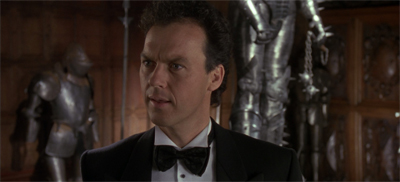
“What, the Joker’s attacking the chemical plant? Mister Wayne’s a little (bow-)tied up at the moment…”
I am, however, less certain about the decision to link the origins of Batman and the Joker. I understand that it’s a pragmatic way of covering various plot points, but it does tend to imply that the death of the Joker should resolve Batman’s issues. After all, he’s finally removed the man who murdered his parents, so surely there must be some emotional relief, right? I’m not entirely convinced by that line of thought, and I’m not sure that it really adds a lot to the movie.
On the other hand, I do like the idea of some form of infinite recursion here, as if there’s some sort of timeless loop between the Joker and Batman. It certainly reinforces the wacky co-dependence that exists between the pair, and does lend an element of fate to their inevitable confrontation. (That said, I’m not convinced that the pair need to be that tightly entwined. After all, The Dark Knight was no worse off for the fact there wasn’t so tight a connection.)
Technically, the film remains impressive. The production design is absolutely fabulous, evoking a comic book neo-noir style that actually suits the character quite well. Even after all these years, I still think that Danny Elfman’s music perfectly suits the character, to the point where I find myself humming his themes when I think of the characters. Burton is a master of mood, and there is a delightful sense of “otherness” to his work here.
The performances are (mostly) great. I think Keaton is sorely underrated as Batman. Nicholson is great at the Joker. Bassinger struggles with a role that feels just a little awkward. Michael Gough is great as a sarcastic Alfred, while Jack Palance chews through some epic scenery in his small role as Boss Grissom. (To the point where the Joker’s attempt at an exaggerated parody seems like an affectionate impression, “You… are my number one… a-guy!”)
On the other hand, the script is just a bit muddled. Vicki Vale still feels like the film’s single biggest problem, a character inserted for a purpose that doesn’t really suit the story being told. I can’t help but feel that, despite Burton’s direction and Keaton’s performance, even Batman himself could be defined a little better. There’s a lot of subtle character work here, but a lot of it feels perhaps too subtle, too deeply buried. The plotting itself feels a little superfluous to the characters and the setting and the mood, with the Joker seeming to plot merely to fill the movie’s runtime rather than as some means to some end. (Or to prove a particular point.)
I like Burton’s Batman, even if I think it’s pretty far from perfect. It is, however, interesting, well-constructed and thoughtful. I do think that the very best of this iteration of the character lay ahead, with Batman Returns perfectly developing and expanding on the ideas suggested here, deepening and broadening this iteration of the character.
Filed under: Non-Review Reviews | Tagged: batman, batman 1989, batman 89, Christopher Nolan, danny elfman, green goblin, jack nicholson, joker, michael keaton, Movie, non-review review, review, tim burton |
















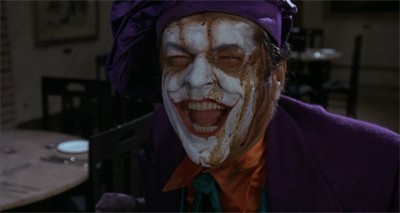
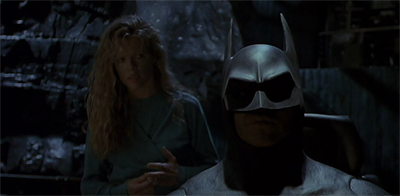
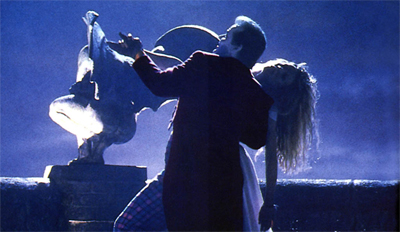
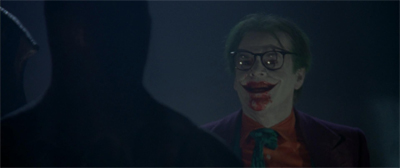
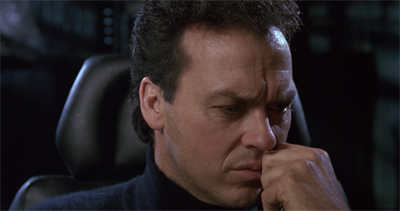
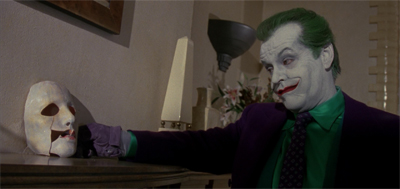
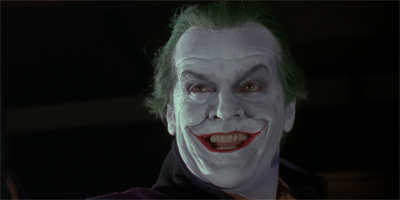
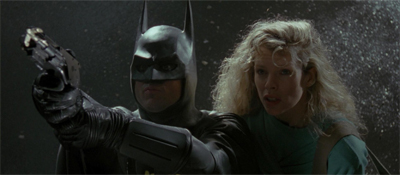







i agree with a lot of what you say – good spot on Nolan nicking the Vale bit – in TDK he also nicks the ‘Joker/Batman on a vehicle’ faceoff in a long city street at night. the music is great from start to finish.
i dont think the movie is a mess – it has dated a little, but it has all the ingredients of a good superhero movie – keaton is a great Wayne
This film probably has the greatest hero villain relationship I’ve ever seen. It’s my personal favorite Batman ever since I heard Tim Burton describe it as “a duel of the freaks”. Batman and Joker are two people that have shaped each others lives and are trapped in an eternal cycle, with them being the fullest extensions of the law and crime, along with inversions of the hero villain stereotypes.
I think Burton’s work on the character is horribly underrated. At the very least, they look beautiful; but they are also very big “mythic” Batman stories in a way distinct from Adam West or Christopher Nolan.